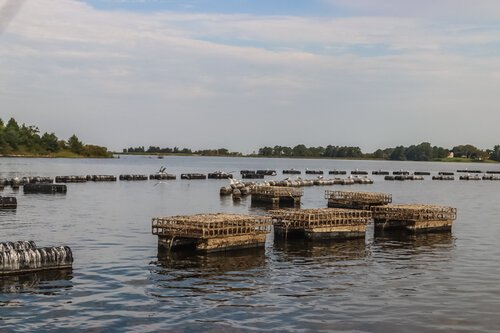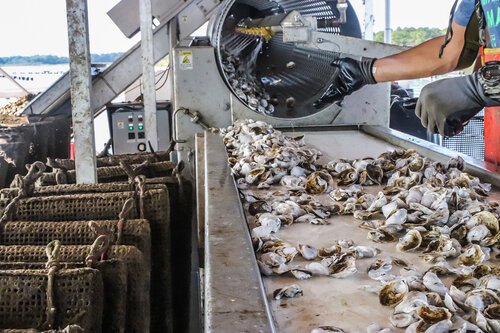Navigating the Chesapeake: The Story of Orchard Point Oyster Co.
Orchard Point Oyster Co. founder Scott Budden left his corporate financial analyst position in Washington D.C. to start a career on the Chesapeake as an oyster farmer. Budden and his team persevered through new statutory enactments and competing private interests to become a Chesapeake oyster farm giant with a massive distribution platform.
Ten years ago, Scott Budden had become weary of the Washington D.C. corporate finance scene. Raised on Maryland's Eastern Shore, Budden, the founder and co-owner of Orchard Point Oyster Company, grew up surrounded by the bounty of the Chesapeake Bay. After college, Budden found himself fully immersed in the corporate world of Washington DC, working as a financial analyst. Although appreciative of his career, Budden longed to trade his world of fluorescent lights and cubicles for the natural beauty of his native Maryland. Budden’s new goal: to find a way to make positive environmental and social impacts working on the water in Maryland.
“I watched the Chester River go through some negative environmental changes over the past thirty-five years, and I wanted to do something in my life that positively impacted the environment,” Budden explained to me during our conversation.
While living in D.C., Budden observed the booming popularity of oysters on the half shell at local bars and restaurants. “It seemed like every restaurant in D.C. served oysters. Whether you were at a trendy bar or a quaint little mom and pop Italian restaurant, everyone had oysters on their menus,” Budden recounted. “Plus, the margins for oysters were good in D.C., and they were a great complimentary food for alcohol.” Putting his analytical skills to work, Budden performed some market research on the oyster scene in Washington D.C., and discovered if he invested in oyster farming, he could accomplish his goals of working on the water, making a positive impact on the environment, and earning an honest living.
“It was definitely a risky career move,” Budden explained, “but it was a calculated risk that was backed by a lot of research, and conversations with those in the aquaculture industry.”
Persevering Through Maryland’s New Aquaculture Regulations
While Budden was prepared to dive headfirst into the world of aquaculture, he first had to jump through the dual hoops of red tape regulation and Chesapeake Bay politics. Maryland’s 400 year bivalve history is perhaps the country’s most intriguing – with tales of dredging oysters under sail to actual “Oyster Wars” between the “Oyster Navy” and “Oyster Pirates” who sought to illegally harvest wild oysters from the Chesapeake.
In Maryland, residents are permitted to harvest an allotted daily number of wild oysters that grow naturally in the Chesapeake. While the harvest of wild oysters has a rich history in Maryland, laws permitting the farming of oysters were not passed until 2010. The farming of oysters would allow applicants to a certain number of acres of water from the State in which to grow oysters from seed to adult size, to be sold commercially. Prior statutory attempts to promote oyster farming on the Chesapeake encountered opposition by public harvesters of wild oysters, who wished to prevent competition. [1] Hopes of laws allowing for oyster farming took a bigger hit in the early 1900s, when the population of the wild Eastern oysters plummeted in the Chesapeake due to overfishing and disease.
While the 2010 legislative enactments opened up 600,000 acres of Maryland’s portion of the Chesapeake Bay for farmers,[2] Budden learned firsthand the process of establishing an oyster farm on the Chesapeake was not a quick one.
“Unfortunately, there is still a lot of resistance from other fisheries and riparian landowners to oyster farming on the Chesapeake,” Budden explained. “I think every oyster farmer I know personally in Maryland has received some push-back during the public comment period of the lease application process.”
The intricacies of Maryland’s infant aquaculture lease process coupled with conflicting private interests delayed Budden’s oyster farm plans by almost four years. Maryland’s oyster lease application process requires approval from the state and the Army Corps of Engineers as well as a public comment period. Budden met intense local skepticism and resistance. Local watermen were concerned his farm would limit their access to the river’s fisheries, and waterfront homeowners were chagrined to look at and navigate around buoys and cages that marked oyster farm sites.
The Rise of Orchard Point Oysters
Despite the adversities, Budden’s determinism and patience paid off. In 2015, Budden acquired his first five acre lease site to grow oysters on the Chesapeake. Orchard Point Oysters began as a boutique endeavor, with 330,000 oyster seed planted its first year. Over the next four years, Budden’s operation exploded in terms of size and popularity. Orchard Point Oyster Co. has increased from five acres to twenty acres, with another five-acre lease site currently under review by the State. This past year, Orchard Point Oysters planted close to 5 million oyster seed – a massive increase from the 330,000 oysters planted in its first year of operations.
In 2018, Budden made the decision to merge Orchard Point Oysters with another local farm, owned by Brian Connelly and Hal McBee, Jr., that was taking up residence in the same area.
“It made perfect sense for me to pair up with Brian and Hal,” Budden explained, “they had quite a bit of infrastructure and equipment, and I had been working on developing the Orchard Point brand and diversifying our sales. It seemed like a great match.” With the merger of two farms, the addition of farm manager Sean Corcoran, and the experience in navigating the oftentimes tumultuous waters of the Maryland aquaculture industry, Orchard Point Oyster Co. was prepared to expand into a mid-Atlantic industry giant.
“I think the strong thing about our business is that every season, everyone on our team learns something new. We grow because we are accepting of learning from our experiences,” Budden noted. “Plus, everyone on our team has the mentality that we will take smart, calculated risks to help our business thrive.”
Perfecting the Product: Site Diversification
Orchard Point Oysters have a unique flavor profile due to the fact they spend half their lives growing in the Eastern Bay, a tributary of the Chesapeake, and the other half of their lives growing on the northeast side of Eastern Neck Island National Wildlife Refuge on the Chester River.
The Eastern Bay site serves as Orchard Point Oyster’s primary market lease. The salinity of the Eastern Bay lease site is higher than that of the Chester River, at 12-20 ppt. There, Budden introduces his yearly batch of baby oysters to the nursery in mid-April. When the baby oysters reach almost ½ an inch, they are then transferred north to floating Oystergro cages on the Chester River. There, the oysters grow year-round until they are almost market size, after about two years. The salinity of the Chester River varies between 8-12 ppt depending on the season. The oysters then make another trip down the river back to the Eastern Bay lease site, where Orchard Point Oyster Co. has a ½ acre portion of the site designated for floating cages for market-ready oysters. If there is no room in the market-ready cages, they hold the oysters in bottom cages until room opens in the floating cages.
For Orchard Point Oysters, the health, aesthetics, and flavor of its oysters are the primary concerns. The team’s goal is to limit the amount of time the oysters spend in bottom cages, because they are not being actively tumbled, which, in turn, impacts their ability to form a teardrop shape. They also made the deliberate decision to finish his oysters at the lease site with a higher salinity. As the salinity of the Eastern Bay lease site rises in the fall and winter, Orchard Point Oysters grow from tasting sweeter in the summer, and brinier in the winter.
Adapting to a Changing Landscape
Since the enactment of laws allowing for oyster farming on the Chesapeake in 2010, and despite the procedural difficulties, over 200 new aquaculture leases have been granted by the Maryland Department of Environmental Resources.[3] The sudden influx of new, farmed oysters has caused a boom in the Maryland restaurant and raw bar scene.
“Instead of going to restaurants in Maryland or DC and only having one or two types of oysters to choose from, diners now have a diverse selection of oysters from a dozen of local farmers,” Budden explained. “It’s been great to see how the Maryland oyster as a brand has been developing since the 2010 legislation.” Orchard Point Oysters have been successfully selling to celebrity chefs like Woodberry Kitchen’s Spike Gjerde, Husk’s Sean Brock, Wolfgang Puck, and other Michelin-starred and James Beard award winners.
Budden shared with me how the current COVID-19 has forced them to re-examine portions of their oyster business. In particular, many farmers depended on selling their product to the restaurant industry as a primary source of income. With restaurants closed, Orchard Point Oyster Co. has taken the opportunity to work on developing the distribution arm of their business. “When the closures started, I think only two area oyster farms were doing direct-to-consumer sales. We had to scramble and pivot from selling primarily to chefs and restaurants to selling to consumers. We started doing curbside service on Maryland’s Eastern Shore, and have found that people really love it,” Budden explained. “While the COVID-19 pandemic has been an impediment to our expansion projects, it has really helped us develop the retail side of our farm. Furthermore, we are a certified FDA dealer/shipper, and have been able to ship our oysters throughout the country. We’ve been able to increase our market presence in the southeastern states during this time, which has been great. Even with the restaurants opening, we still plan on keeping our nationwide shipping option, which will be a great way to further expand our business.”
Budden hopes to use his distribution experience to one day pitch a co-op model of distribution to other Chesapeake oyster farmers. “Given the challenges facing our industry, it would be great to unite to create a platform to partner with several other Chesapeake farms to distribute our oysters nationally,” Budden relayed. His other goal would be to rally farmers to band together to create a model of oyster ecotourism in the state.
Cooking with Orchard Point Oysters
“Our oysters have a good balance of brine and sweetness in the summer, and a buttery sweetness as the weather cools,” Budden shared, “Orchard Points are a great introductory oyster because they don’t overpower you with brine or sweetness—they are balanced.”
Orchard Point oysters are a favorite amongst chefs in the mid-Atlantic region because their balanced flavor profile makes them a terrific canvas for other ingredients. During our conversation, Budden revealed his top two favorite ways to prepare Orchard Point Oysters.
“If you like your oysters raw, I love our oysters with some smoky mezcal and a slice of jalapeno,” Budden oozed “the combination of the smokiness and spiciness of the accompaniments pairs really well with the butteriness of our oyster.”
Budden went on “and whenever my team grills our oysters at events, we like to make it spicy. We place our shucked oysters on the grill with a pad of butter, a dash of good hot sauce, and a sprinkling of panko.” Budden explained that in the mid-Atlantic region, folks love Snake Oil, a hot sauce made with fish peppers, apple cider vinegar, and sea salt. “People in the Chesapeake region love adding some heat to their oysters, and we love shucking our oysters at events and getting to share our ever-growing list of recipes with our community.”
[1] Laws seeking to promote oyster culture passed in 1820, 1865, and 1906 but encountered opposition from public harvesters wishing to prevent competition. A recent study by the University of Maryland Center for Environmental Science found that the number of oysters in Maryland waters fell by two-thirds from 1999 to 2002 alone, to about 200 million. The population has since rebounded to an estimated 300 million oysters, still less than 1% of pre-colonial abundance
[2] It left 168,000 acres for wild harvest. Since then, the number of oysters farmed in Maryland waters has grown more than 20 times over, equaling about one-third the haul of wild oysters watermen dredge up every year
[3] http://www.baltimoresun.com/news/environment/bs-md-aquaculture-growth-20190225-story.html






